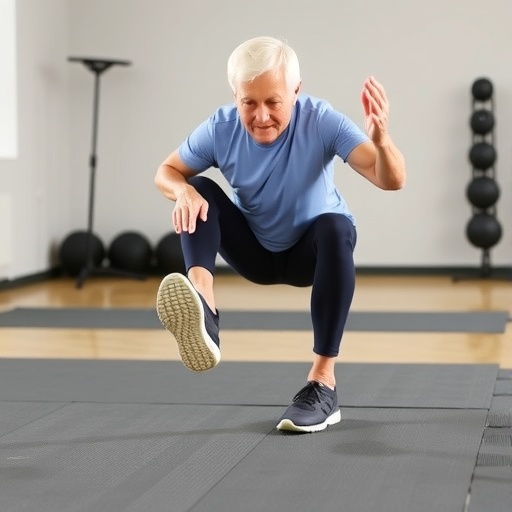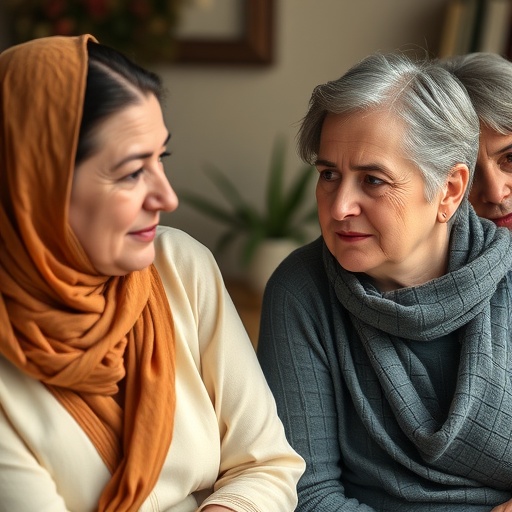In a groundbreaking study published in BMC Geriatrics, researchers have illuminated the impact of intrinsic foot muscle training coupled with lower extremity resistance training on postural stability in older adults. This randomized controlled trial investigates an often overlooked aspect of physical health, emphasizing the role of foot strength and stability in maintaining balance. As the aging population increases globally, understanding how to enhance stability and reduce fall risks becomes increasingly critical. The research provides compelling evidence supporting tailored exercise regimens aimed at fostering a healthier, more active lifestyle among older individuals.
Foot health is pivotal for overall well-being, particularly for older adults who are more susceptible to falls due to decreased muscle strength and coordination. Intrinsic foot muscles, which lie deep within the foot, play a crucial role in maintaining balance and structural integrity. This study postulates that by specifically training these muscles in conjunction with traditional resistance exercises for the lower extremities, participants can significantly improve their postural stability, a crucial factor in falls prevention.
The study involved a substantial cohort of older adults who were randomly assigned to either the intervention group, which engaged in both intrinsic foot muscle training and lower extremity resistance training, or the control group, which continued with their regular activities. Over a predetermined duration, researchers meticulously monitored the participants’ progress. This methodologically rigorous approach ensured the collection of robust data concerning the participants’ balance and stability, shedding light on the effectiveness of the combined training regimen.
Intrinsic foot muscle training, arguably the cornerstone of the intervention, involves exercises designed to strengthen the muscles within the foot itself. These exercises often escalate in difficulty and are intended to enhance not just strength but also neuromuscular control and proprioception. Previous studies have offered insights into how foot muscle training can improve balance, yet this research takes it a step further by integrating it with resistance training, thereby creating a multifunctional approach to enhancing stability in older adults.
Resistance training, on the other hand, is widely recognized for its role in building muscle strength and endurance. For older adults, engaging in resistance training has been shown to combat age-related muscle loss, which has a direct correlation with balance and mobility. However, while resistance training typically focuses on larger muscle groups—like those in the legs and core—this study brings attention to the synergistic benefits of incorporating foot muscle training into the mix.
As the trial progressed, participants underwent a series of assessments, measuring various parameters linked to postural stability. Standardized balance tests, including the Berg Balance Scale, provided quantitative data on improvements or declines in stability, allowing researchers to draw meaningful conclusions about the effectiveness of the training. The results illuminated significant advancements in balance among those who participated in the combined training program, highlighting the importance of comprehensive exercise regimens tailored for older adults.
One of the fascinating aspects of the results is the potential for these training methods to be easily integrated into the daily routines of older adults. The exercises designed for intrinsic foot muscle strengthening can often be performed in the comfort of one’s home, requiring minimal equipment. This accessibility presents a remarkable opportunity for health professionals and caregivers to implement these strategies without necessitating specialized settings or resources.
Moreover, the implications of this study extend beyond merely enhancing stability; they touch on broader themes related to the quality of life in older adults. Being able to maintain balance not only decreases the likelihood of falls but also fosters independence, allowing older individuals to engage more actively in their communities and with their families. This is not just a matter of physical health but psychological well-being as well.
While the findings are promising, researchers urge caution regarding the generalizability of the results. The demographic of participants—predominantly older adults within a specific community—suggests that future studies should aim for a more diverse sample population. By doing so, the applicability of these findings can be more universally recognized and implemented across varying contexts.
Additionally, researchers identified potential areas for further investigation. They suggest exploring different variations of foot muscle exercises, as well as examining how other factors—such as diet, comorbidities, and environmental conditions—might influence the outcomes of similar training programs. Each of these factors could provide further insights into optimizing health interventions for older adults.
In conclusion, the research adds a vital dimension to our understanding of fall prevention and balance improvement methods for older adults. It challenges conventional approaches by advocating for intrinsic foot muscle training as a pivotal element in the quest for enhanced stability and well-being. As the discourse surrounding active aging continues to evolve, studies like this will be essential in shaping effective strategies that prioritize both safety and quality of life for an aging population.
The implications of this research resonate deeply within the fields of geriatrics and rehabilitation. By firmly establishing the connection between foot muscle strength, overall stability, and fall prevention, professionals in these areas are now equipped with a more comprehensive toolkit to address the challenges faced by older adults. As society moves forward, investing in such research will be fundamental to fostering healthier, more resilient communities where seniors can thrive.
In light of the ever-pressing need for innovative health solutions, studies like this one are not just academic; they are a call to action for health professionals, caregivers, and the broader community to prioritize aspects of health that significantly impact the aging population. The results encourage a shift in focus toward holistic interventions that enhance strength, balance, and ultimately, quality of life, paving the way for older adults to live their lives to the fullest.
As we await future research that builds on these foundational findings, the hope is that communities will rally around the necessity of supporting older adults through tailored exercise programs that are easily accessible, enjoyable, and impactful. The road to better balance and stability is one that can redefine the aging experience, and this study provides the blueprint for development and implementation.
The combination of intrinsic foot muscle training with lower extremity resistance training stands as a testament to the need for comprehensive approaches in elderly care, promising not only improved physical capabilities but also enhanced dignity and independence for older adults everywhere.
Subject of Research: Effects of intrinsic foot muscle training combined with lower extremity resistance training on postural stability in older adults.
Article Title: Effects of intrinsic foot muscle training combined with lower extremity resistance training on postural stability in older adults: a randomised controlled trial.
Article References:
Lai, Z., Cao, M., Wang, R. et al. Effects of intrinsic foot muscle training combined with the lower extremity resistance training on postural stability in older adults: a randomised controlled trial.
BMC Geriatr 25, 732 (2025). https://doi.org/10.1186/s12877-025-06407-5
Image Credits: AI Generated
DOI: 10.1186/s12877-025-06407-5
Keywords: Intrinsic foot muscle training, Lower extremity resistance training, Postural stability, Older adults, Fall prevention.
Tags: balance improvement in seniorsBMC Geriatrics study on seniorsenhancing stability in older individualsexercise regimens for aging populationfall prevention strategies for elderlyfoot strength training for seniorsintrinsic foot muscle exerciseslower extremity resistance trainingphysical health and falls riskpostural stability in older adultsresearch on foot health and agingtailored exercise programs for elderly





